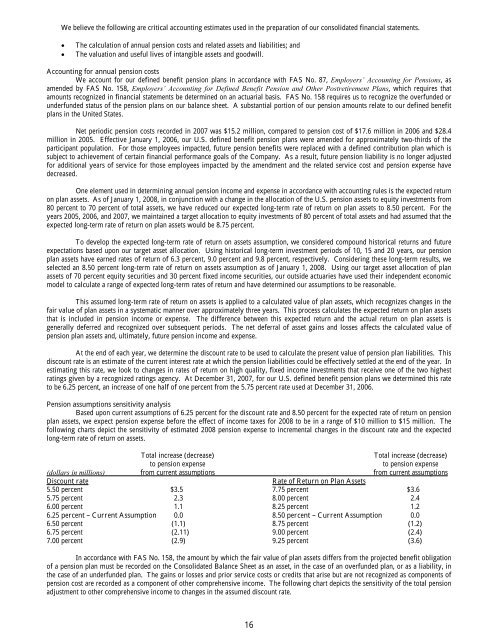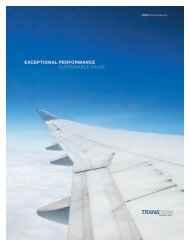Bemis Company 2007 Annual Report - IR Solutions
Bemis Company 2007 Annual Report - IR Solutions
Bemis Company 2007 Annual Report - IR Solutions
Create successful ePaper yourself
Turn your PDF publications into a flip-book with our unique Google optimized e-Paper software.
We believe the following are critical accounting estimates used in the preparation of our consolidated financial statements.<br />
<br />
<br />
The calculation of annual pension costs and related assets and liabilities; and<br />
The valuation and useful lives of intangible assets and goodwill.<br />
Accounting for annual pension costs<br />
We account for our defined benefit pension plans in accordance with FAS No. 87, Employers’ Accounting for Pensions, as<br />
amended by FAS No. 158, Employers’ Accounting for Defined Benefit Pension and Other Postretirement Plans, which requires that<br />
amounts recognized in financial statements be determined on an actuarial basis. FAS No. 158 requires us to recognize the overfunded or<br />
underfunded status of the pension plans on our balance sheet. A substantial portion of our pension amounts relate to our defined benefit<br />
plans in the United States.<br />
Net periodic pension costs recorded in <strong>2007</strong> was $15.2 million, compared to pension cost of $17.6 million in 2006 and $28.4<br />
million in 2005. Effective January 1, 2006, our U.S. defined benefit pension plans were amended for approximately two-thirds of the<br />
participant population. For those employees impacted, future pension benefits were replaced with a defined contribution plan which is<br />
subject to achievement of certain financial performance goals of the <strong>Company</strong>. As a result, future pension liability is no longer adjusted<br />
for additional years of service for those employees impacted by the amendment and the related service cost and pension expense have<br />
decreased.<br />
One element used in determining annual pension income and expense in accordance with accounting rules is the expected return<br />
on plan assets. As of January 1, 2008, in conjunction with a change in the allocation of the U.S. pension assets to equity investments from<br />
80 percent to 70 percent of total assets, we have reduced our expected long-term rate of return on plan assets to 8.50 percent. For the<br />
years 2005, 2006, and <strong>2007</strong>, we maintained a target allocation to equity investments of 80 percent of total assets and had assumed that the<br />
expected long-term rate of return on plan assets would be 8.75 percent.<br />
To develop the expected long-term rate of return on assets assumption, we considered compound historical returns and future<br />
expectations based upon our target asset allocation. Using historical long-term investment periods of 10, 15 and 20 years, our pension<br />
plan assets have earned rates of return of 6.3 percent, 9.0 percent and 9.8 percent, respectively. Considering these long-term results, we<br />
selected an 8.50 percent long-term rate of return on assets assumption as of January 1, 2008. Using our target asset allocation of plan<br />
assets of 70 percent equity securities and 30 percent fixed income securities, our outside actuaries have used their independent economic<br />
model to calculate a range of expected long-term rates of return and have determined our assumptions to be reasonable.<br />
This assumed long-term rate of return on assets is applied to a calculated value of plan assets, which recognizes changes in the<br />
fair value of plan assets in a systematic manner over approximately three years. This process calculates the expected return on plan assets<br />
that is included in pension income or expense. The difference between this expected return and the actual return on plan assets is<br />
generally deferred and recognized over subsequent periods. The net deferral of asset gains and losses affects the calculated value of<br />
pension plan assets and, ultimately, future pension income and expense.<br />
At the end of each year, we determine the discount rate to be used to calculate the present value of pension plan liabilities. This<br />
discount rate is an estimate of the current interest rate at which the pension liabilities could be effectively settled at the end of the year. In<br />
estimating this rate, we look to changes in rates of return on high quality, fixed income investments that receive one of the two highest<br />
ratings given by a recognized ratings agency. At December 31, <strong>2007</strong>, for our U.S. defined benefit pension plans we determined this rate<br />
to be 6.25 percent, an increase of one half of one percent from the 5.75 percent rate used at December 31, 2006.<br />
Pension assumptions sensitivity analysis<br />
Based upon current assumptions of 6.25 percent for the discount rate and 8.50 percent for the expected rate of return on pension<br />
plan assets, we expect pension expense before the effect of income taxes for 2008 to be in a range of $10 million to $15 million. The<br />
following charts depict the sensitivity of estimated 2008 pension expense to incremental changes in the discount rate and the expected<br />
long-term rate of return on assets.<br />
Total increase (decrease)<br />
Total increase (decrease)<br />
to pension expense<br />
to pension expense<br />
(dollars in millions) from current assumptions from current assumptions<br />
Discount rate<br />
Rate of Return on Plan Assets<br />
5.50 percent $3.5 7.75 percent $3.6<br />
5.75 percent 2.3 8.00 percent 2.4<br />
6.00 percent 1.1 8.25 percent 1.2<br />
6.25 percent – Current Assumption 0.0 8.50 percent – Current Assumption 0.0<br />
6.50 percent (1.1) 8.75 percent (1.2)<br />
6.75 percent (2.11) 9.00 percent (2.4)<br />
7.00 percent (2.9) 9.25 percent (3.6)<br />
In accordance with FAS No. 158, the amount by which the fair value of plan assets differs from the projected benefit obligation<br />
of a pension plan must be recorded on the Consolidated Balance Sheet as an asset, in the case of an overfunded plan, or as a liability, in<br />
the case of an underfunded plan. The gains or losses and prior service costs or credits that arise but are not recognized as components of<br />
pension cost are recorded as a component of other comprehensive income. The following chart depicts the sensitivity of the total pension<br />
adjustment to other comprehensive income to changes in the assumed discount rate.<br />
16







